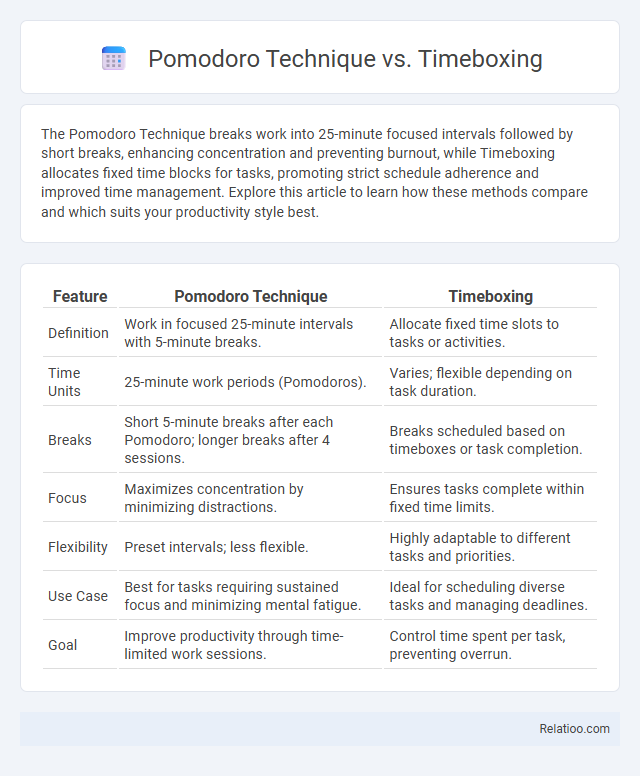The Pomodoro Technique breaks work into 25-minute focused intervals followed by short breaks, enhancing concentration and preventing burnout, while Timeboxing allocates fixed time blocks for tasks, promoting strict schedule adherence and improved time management. Explore this article to learn how these methods compare and which suits your productivity style best.
Table of Comparison
| Feature | Pomodoro Technique | Timeboxing |
|---|---|---|
| Definition | Work in focused 25-minute intervals with 5-minute breaks. | Allocate fixed time slots to tasks or activities. |
| Time Units | 25-minute work periods (Pomodoros). | Varies; flexible depending on task duration. |
| Breaks | Short 5-minute breaks after each Pomodoro; longer breaks after 4 sessions. | Breaks scheduled based on timeboxes or task completion. |
| Focus | Maximizes concentration by minimizing distractions. | Ensures tasks complete within fixed time limits. |
| Flexibility | Preset intervals; less flexible. | Highly adaptable to different tasks and priorities. |
| Use Case | Best for tasks requiring sustained focus and minimizing mental fatigue. | Ideal for scheduling diverse tasks and managing deadlines. |
| Goal | Improve productivity through time-limited work sessions. | Control time spent per task, preventing overrun. |
Introduction to Pomodoro Technique and Timeboxing
The Pomodoro Technique breaks work into focused 25-minute intervals separated by short breaks, enhancing concentration and reducing burnout, while Timeboxing allocates fixed time blocks for tasks to manage priorities and maintain productivity. Both strategies aim to improve time management by structuring your workday, preventing procrastination, and boosting efficiency. Choosing the right method depends on your workflow and how you balance task intensity with scheduled rest periods.
Core Principles of Pomodoro Technique
The Pomodoro Technique centers on breaking work into focused 25-minute intervals called Pomodoros, separated by short breaks to enhance concentration and prevent burnout. Timeboxing schedules fixed blocks of time for tasks but may vary in length, prioritizing overall time management and flexibility. The Pomodoro Technique's core principles emphasize strict timing, regular rest, and single-task focus, making it highly effective for maintaining productivity by minimizing distractions and managing mental energy.
Core Principles of Timeboxing
Timeboxing revolves around allocating fixed, rigid time slots to specific tasks, ensuring strict adherence to these limits to prevent overruns and promote focused productivity. Unlike the Pomodoro Technique, which uses short, repetitive intervals with breaks, timeboxing emphasizes broader, predefined periods tailored to task complexity and priority. Mastering timeboxing enhances your workflow discipline by enforcing deadlines and reducing procrastination, directly supporting improved productivity outcomes.
Key Differences Between Pomodoro and Timeboxing
The Pomodoro Technique divides work into fixed 25-minute intervals called pomodoros with short breaks, promoting intense focus and regular rest to prevent burnout. Timeboxing allocates specific blocks of time to tasks without fixed durations, offering greater flexibility to manage complex or varying workloads. Understanding these differences helps you choose a productivity method tailored to your work style and enhances time management effectiveness.
Advantages of the Pomodoro Technique
The Pomodoro Technique enhances productivity by breaking work into focused 25-minute intervals, promoting sustained concentration and minimizing mental fatigue. Unlike timeboxing, which allocates variable lengths to tasks, the Pomodoro method maintains consistent timing, aiding in habit formation and time management. Its built-in short breaks improve cognitive function and reduce burnout, making it a practical tool for boosting efficiency in diverse work environments.
Benefits of Timeboxing
Timeboxing enhances productivity by allocating fixed time periods to specific tasks, preventing procrastination and ensuring focused work sessions. It reduces decision fatigue through predefined schedules, leading to improved time management and task prioritization. Unlike the Pomodoro Technique, timeboxing offers greater flexibility by allowing variable block lengths tailored to task complexity and individual workflows.
Productivity Scenarios: When to Use Pomodoro
The Pomodoro Technique is ideal for boosting productivity in tasks requiring focused attention for short bursts, such as studying or writing, by breaking work into 25-minute intervals with frequent breaks. Timeboxing works best when managing a diverse schedule, allocating fixed time slots for different activities to maintain overall workflow balance. Your productivity improves by selecting Pomodoro during moments when avoiding burnout and maintaining high concentration levels are crucial.
Productivity Scenarios: When to Use Timeboxing
Timeboxing excels in complex productivity scenarios requiring strict deadlines and diverse task management, such as project planning and software development sprints. This technique enhances focus by allocating fixed time periods for tasks, preventing overcommitment and improving time allocation accuracy. Compared to the Pomodoro Technique, Timeboxing is more effective in environments where flexible yet bounded work sessions are necessary to meet broader goals.
Common Challenges and Solutions
Pomodoro Technique, Timeboxing, and Productivity methods often face common challenges such as maintaining focus, managing distractions, and balancing tasks within limited time frames. You can overcome these difficulties by setting clear goals, prioritizing tasks based on urgency and importance, and using tools like timers or digital calendars to enforce time blocks effectively. Consistent review and adjustment of your workflow help enhance productivity by aligning work intervals with your optimal focus patterns.
Choosing the Right Method for Your Workflow
The Pomodoro Technique enhances focus by breaking work into 25-minute intervals with short breaks, ideal for tasks requiring sustained concentration. Timeboxing allocates fixed time slots for specific activities, promoting discipline and preventing task overruns in varied workflows. Selecting the right productivity method depends on personal work habits, task complexity, and the need for flexibility versus structured time management.

Infographic: Pomodoro Technique vs Timeboxing
 relatioo.com
relatioo.com